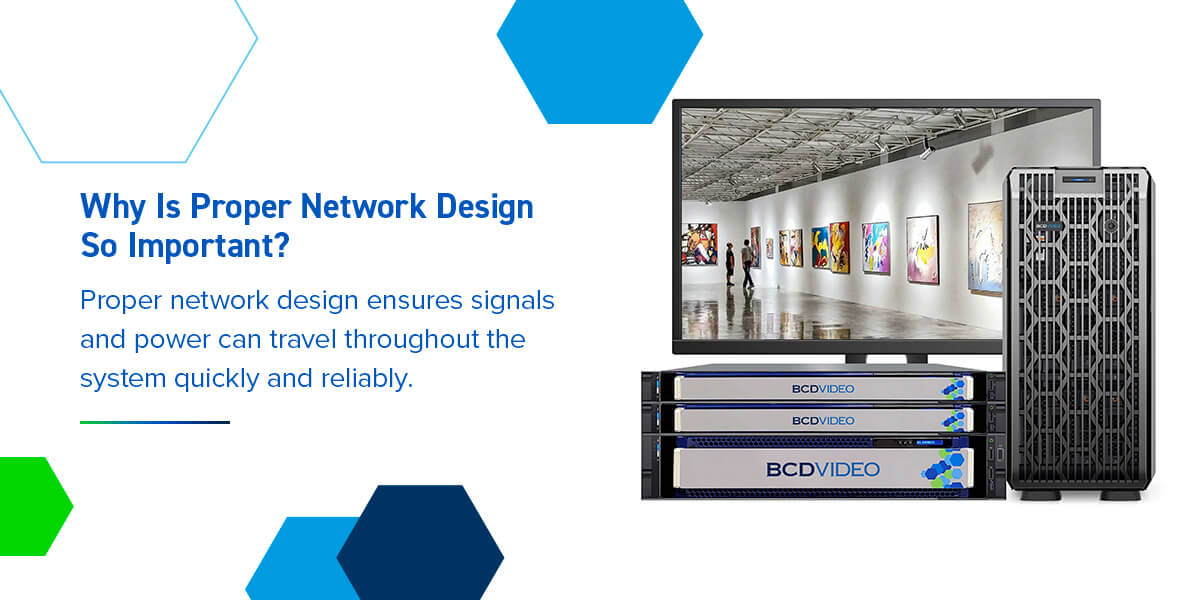When selecting hardware for your CCTV system, it’s easy to get carried away with choosing the perfect components based on performance specifications alone.
But when it comes to the whole system, each device’s capabilities suddenly become much less critical. From this much broader perspective, it only matters that your devices work together efficiently to capture, record and store footage.
In this quick guide, we’ll discuss how to design a security network that meets your video surveillance implementation specifications.
What Is Network Design?
Creating a network for video surveillance has become significantly more complex now that internet protocol (IP) and power over Ethernet (PoE) systems have replaced analog. A key part of ensuring these new devices work is paying careful attention to every detail of your network design.
There are two vital factors to consider before choosing any other system components:
- Bandwidth: Bandwidth refers to your system’s maximum capacity for sending and receiving data across the network. The number of cameras routed to your network switch determines the bandwidth you need to ensure your system works properly.
- PoE: A PoE connection enables you to power network devices with a single network cable rather than needing to connect to a separate power source. Like bandwidth, PoE demands have increased over the years — the more devices you have on one network, the higher PoE you’ll need to provide sufficient power.
Of course, these two factors also depend on the other components you include in your IP security system.
Important Components of an IP Camera Network
Unlike the analog systems of the past, today’s IP CCTV networks are complex, with many different moving parts. It’s essential to take a holistic approach to selecting devices for your network to ensure everything integrates well.
Here’s what you’ll need to design a complete PoE network:
- PoE switch: Your PoE switch enables you to power all devices in the system using network cables and an Ethernet connection. The switch’s spec sheet will tell you the power requirements for the rest of your system.
- Network video recorder (NVR): The NVR receives the footage from your cameras, which it processes and records for future access.
- IP cameras: Unlike analog cameras, IP cameras rely on an internet or network connection to send and receive footage.
- Network cable: Each cable type has different characteristics that can impact performance. Two important cable considerations include resistance and capacitance, which affect the amount of power a cable can provide.
Your endpoints — the network devices that receive and process footage — are especially important because they interface with you directly. You need to make sure your endpoint devices, such as NVRs or servers, have enough bandwidth to handle all the images you’ll send to them.
Why Is Proper Network Design So Important?
Proper network design ensures signals and power can travel throughout the system quickly and reliably.
For example, IP cameras usually cause slight power surges at night when accessory functions activate. You need to ensure your PoE source can provide enough power for normal operation and abnormal power surges to have consistent coverage in all conditions.
Here are some of the other reasons why proper network design is critical for a functioning CCTV system:
- Compatibility: Each piece of your network needs to be compatible with your PoE switch and the other components in the system to function properly.
- Scalability: If you think you will need to expand your system in the future, you must design your network to allow for future growth.
- Performance: Optimizing network design improves performance and reduces latency to deliver excellent results to your end users.
- Cost savings: Good network design is streamlined and simple — with fewer appliances to manage, you can save on routine maintenance and upgrades.
- Security: Well-designed networks are better protected against internet-based threats like unauthorized remote access and video hacking.
Of course, it’s important to remember what can happen when you neglect to spend adequate time on network design.
Possible Complications of Improper Network Design
Functional issues are common in poorly designed video networks. Video loss, for example, is a serious complication that can happen due to improper networking. In a poorly designed network system, there is a risk that one or more cameras could lose video feeds during power surges. As a result, the monitor loses visibility of the area, which can lead to severe consequences.
It’s also possible that parts of your system may not be compatible with others. Incompatible CCTV components can cost you valuable time and money in equipment.
BCD Professional Network Services
Smooth installation and implementation can be challenging with limited resources. If you need help ensuring your end user’s CCTV system works as intended, our professional network services are for you.
Network Design
The right hardware is necessary for delivering the high level of performance your end users need to protect their businesses reliably. Our professional team has extensive training and experience working with a wide range of top-tier networking products, so you can rely on them to design a turnkey solution that meets your system’s unique specifications.
Plus, we have established strong partnerships with leading vendors in networking technology, giving you access to the latest in low-latency networking hardware.
Network Assessment
Sometimes, certain components perform differently than expected when you put them under the stresses of everyday operation. That’s why taking time to evaluate your network is essential for ensuring everything works as it should.
Our team can perform pre- and post-deployment analyses to ensure your installation runs according to your specifications. If we find any inefficiencies or communication breakdowns in the system, we can recommend solutions to resolve these issues and further optimize your network.
Network Deployment and Provisioning
BCD also offers configuration services for businesses that prefer to handle their own network design and hardware decisions. Our team of service professionals has extensive knowledge of networking protocol theory, which enables them to configure your chosen hardware for optimal function. Whatever the end user’s needs, we’ll work closely with you to meet them.
Trust BCD’s Expert Network Design for Video Surveillance
If you need help choosing or configuring network devices in your IP security system, the experts at BCD Video can help you. Before deployment, we test and validate every appliance in your system to ensure they meet site performance requirements.
And our partnerships with industry-leading technology vendors help us design best-of-breed security systems for small to medium-sized businesses in industries from casinos to retail. Ask your security integrator to contact us online for more information on our products and services.



